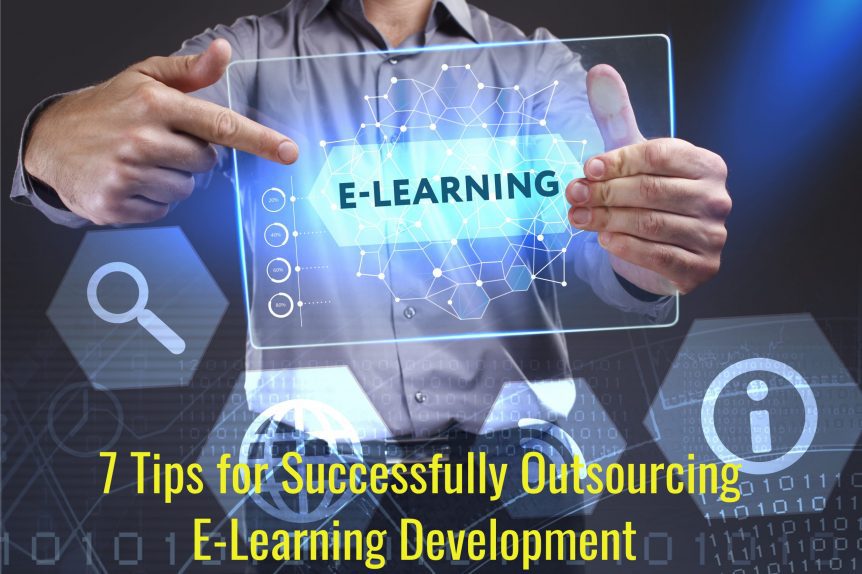7 Tips for Successfully Outsourcing E-Learning Development
Outsourcing e-learning development is a good choice for a range of reasons, not least because you will get a high-quality and professional training course. Your course can also have the latest technical and interactive features, and it will be developed to maximise return on investment.
However, simply outsourcing to an e-learning developer in the UAE or Saudi Arabia won’t guarantee success. Instead, you need to make sure you take steps to prepare for outsourcing and then to ensure the project runs smoothly, on-time, and within budget.
Here are our seven tips for successfully outsourcing your next e-learning development project.
-
Decide on Your Learning Objectives
This step is crucial as learning objectives help everyone involved in the project, from you and your team through to subject matter experts (SMEs), content creators, and developers. Even the learners who will go through the e-learning course when it is completed benefit from clearly defined learning objectives.
What is a learning objective, though? Learning objectives explain what learners will be able to do or understand after they complete the course.
Importantly, learning objectives are not about the goals or objectives of your business or a specific business unit. Instead, they should narrowly focus on the e-learning course you want to create, why you are creating it, and what you want the learner to achieve.
-
Decide on What Aspects of the Development You Are Going to Outsource
There are many different ways of approaching the outsourcing of e-learning development, as there are various elements that are required to put the course together. The main elements include:
- Instructional design for storyboarding
- Content research and curation
- Content creation
- Technical development
You can outsource some of the elements above, or you can outsource the entire project.
-
Focus on Return on Investment
Focusing on the cost of e-learning development is likely to limit the potential of the project. For example, too much emphasis on cost can result in you accepting a low-priced quote and then ending up with a sub-standard e-learning course that doesn’t deliver on your learning objectives.
It is much better to focus on return on investment rather than costs. This can involve looking at how you will measure success and what that success will look like. You will have a much clearer idea of what you should be aiming for if you take this approach.
-
Be Realistic with Expectations
Including highly technical interactive elements can improve the quality of your e-learning course, enhancing results and levels of learner satisfaction. That said, these sorts of complex elements will also increase the cost of development. Therefore, it is important you are realistic with your expectations in terms of budget.
The same applies to timelines. You may have to pay more if you want the course completed on a tight timescale, plus timescales that are too tight might not even be feasible. Being realistic with expectations in these areas is important too.
-
Choose the Right E-Learning Developer
Make sure you take time to select the right e-learning developer. It can be worthwhile speaking to more than one company so you can compare quotes, capabilities, and service offerings.
When going through this process, there are a few things you should consider:
- Does the developer have a good level of e-learning development experience? Does that experience include companies similar to yours or training courses similar to the one you want to develop?
- Does the e-learning developer have knowledge of advanced e-learning strategies and methodologies, including mobile learning, microlearning, blended learning, etc?
- Does the learning developer take an agile development approach, where development takes place in short bursts and where review requests are frequent? This is a much more efficient approach than going through the full development process and then sending the final product to the customer for review. In this latter situation, changes and amendments are much more costly and time-consuming to implement compared to the agile development approach.
- Does the developer have good communication and collaboration structures and processes?
-
Allocate Time and Resources for Feedback, Content Creation, Etc
The e-learning development process will require your input on a regular basis. At the start, you will be involved in helping the developer get an understanding of your business and what you want to achieve with the e-learning course. You will then be involved in the content curation and creating stage, liaising with SMEs, approving content, etc.
You will be involved in the design stage, too, providing feedback on the development, and you will be involved at the end, helping to get the project over the line by getting final sign-off.
Therefore, it is important you allocate sufficient time and resources to keep the development process moving forward. It often helps to have single points of contact both on your side and at the developer.
-
Ensure All Relevant Stakeholders Are Engaged from the Beginning
Getting SMEs and other essential stakeholders engaged in the process from the beginning can be challenging as there are often many pressures on their time. However, problems can occur if they don’t engage with the process until part way through, particularly if they identify something that has to be changed.
The changes could be down to taste and style preferences, or they could be more fundamental. Either way, the further the development process is from the beginning, the more costly and time-consuming it is to make changes.
E-Learning Outsourcing Success
Developing a high-quality e-learning course requires multiple skills. Those skills usually don’t fully exist in companies other than in professional e-learning development agencies. Therefore, outsourcing e-learning makes sense. The tips on this blog will help ensure your e-learning outsourcing project is successful and delivers a return on investment.
